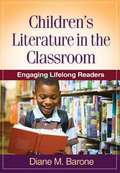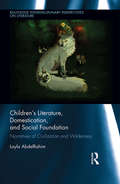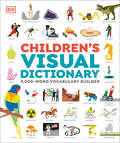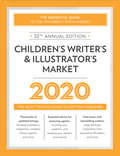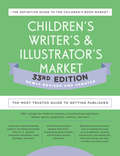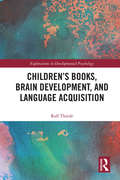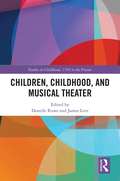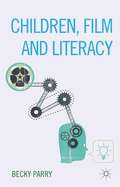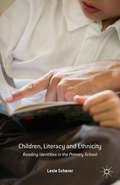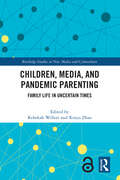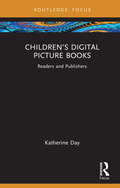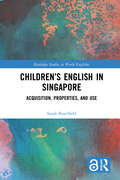- Table View
- List View
Children's Literature in Translation: Challenges and Strategies (G - Reference, Information And Interdisciplinary Subjects Ser. #2)
by Jan Van Coillie Walter P. VerschuerenChildren's classics from Alice in Wonderland to the works of Astrid Lindgren, Roald Dahl, J.K. Rowling and Philip Pullman are now generally recognized as literary achievements that from a translator's point of view are no less demanding than 'serious' (adult) literature. This volume attempts to explore the various challenges posed by the translation of children's literature and at the same time highlight some of the strategies that translators can and do follow when facing these challenges. A variety of translation theories and concepts are put to critical use, including Even-Zohar's polysystem theory, Toury's concept of norms, Venuti's views on foreignizing and domesticating translations and on the translator's (in)visibility, and Chesterman's prototypical approach. Topics include the ethics of translating for children, the importance of child(hood) images, the 'revelation' of the translator in prefaces, the role of translated children's books in the establishment of literary canons, the status of translations in the former East Germany; questions of taboo and censorship in the translation of adolescent novels, the collision of norms in different translations of a Swedish children's classic, the handling of 'cultural intertextuality' in the Spanish translations of contemporary British fantasy books, strategies for translating cultural markers such as juvenile expressions, functional shifts caused by different translation strategies dealing with character names, and complex translation strategies used in dealing with the dual audience in Hans Christian Andersen's fairy tales and in Salman Rushdie's Haroun and the Sea of Stories.
Children's Literature in the Classroom
by Diane BaroneMany reading programs today overlook an essential component of literacy instruction-helping children develop an enduring love of reading. This authoritative and accessible guide provides a wealth of ideas for incorporating high-quality children's books of all kinds into K-6 classrooms. Numerous practical strategies are presented for engaging students with picture books, fiction, nonfiction, and nontraditional texts. Lively descriptions of recommended books and activities are interspersed with invaluable tips for fitting authentic reading experiences into the busy school day. Every chapter concludes with reflection questions and suggestions for further reading. The volume also features reproducible worksheets and forms.
Children's Literature in the Reading Program, Fifth Edition: Engaging Young Readers in the 21st Century
by Bernice E. Cullinan Richard L. Allington Deborah A. Wooten Lauren Aimonette LiangThis indispensable teacher resource and course text, now revised and updated, addresses the "whats," "whys," and "how-tos" of incorporating outstanding children's literature into the K–8 reading program. A strong emphasis on diverse literature is woven throughout the fifth edition, with chapters emphasizing the need for books that reflect their readers and presenting dozens of carefully reviewed books that teachers will be eager to use in the classroom. Leading authorities provide advice on selecting texts, building core literacy and literary skills, supporting struggling readers, and maximizing engagement. The volume offers proven strategies for teaching specific genres and formats, such as fiction, nonfiction, picturebooks, graphic novels, biographies, and poetry. This title is a copublication with the International Literacy Association. New to This Edition *Many new teaching ideas and book recommendations, with an increased focus on culturally diverse literature. *Scope expanded from K–5 to K–8. *Chapter on using read-alouds and silent reading. *Chapters on diverse literature about the arts and on transitional chapter books. *Chapter on engaging struggling readers with authentic reading experiences.
Children's Literature, Briefly
by Terrell Young Michael Tunnell James Jacobs Gregory BryanA concise, engaging, practical overview of children’s books that keeps the focus on the books themselves, this brief introduction to children’s literature genres leaves time to actually read children’s books. Written on the assumption that the focus of a children’s literature course should be on the actual books that children read, the authors first wrote this book in 1996 as a “textbook for people who don’t like children’s literature textbooks.” Today it serves as an overview to shed light on the essentials of children’s literature and how to use it effectively with young readers, from PreK to 8th grade.
Children's Literature, Domestication, and Social Foundation: Narratives of Civilization and Wilderness (Routledge Interdisciplinary Perspectives on Literature)
by Layla AbdelRahimThis study of children's literature as knowledge, culture, and social foundation bridges the gap between science and literature and examines the interconnectedness of fiction and reality as a two-way road. The book investigates how the civilized narrative orders experience by means of segregation, domestication, breeding, and extermination, arguing instead that the stories and narratives of wilderness project chaos and infinite possibilities for experiencing the world through a diverse community of life. AbdelRahim engages these narratives in a dialogue with each other and traces their expression in the various disciplines and books written for both children and adults, analyzing the manifestation of fictional narratives in real life. This is both an inter- and multi-disciplinary endeavor that is reflected in the combination of research methods drawn from anthropology and literary studies as well as in the tracing of the narratives of order and chaos, or civilization and wilderness, in children's literature and our world. Chapters compare and contrast fictional children's books that offer different real-world socio-economic paradigms, such as A.A. Milne's Winnie-the-Pooh projecting a civilized monarcho-capitalist world, Nikolai Nosov's trilogy on The Adventures of Dunno and Friends presenting the challenges and feats of an anarcho-socialist society in evolution from primitivism towards technology, and Tove Jansson's Moominbooks depicting the harmony of anarchy, chaos, and wildness. AbdelRahim examines the construction, transmission, and acquisition of knowledge in children’s literature by visiting the very nature of literature, culture, and language and the civilized structures that domesticate the world. She brings radically new perspectives to the knowledge, culture, and construction of human beings, making an invaluable contribution to a wide range of disciplines and for those engaged in revolutionizing contemporary debates on the nature of knowledge, human identity, and the world.
Children's Literature: A Reader's History, from Aesop to Harry Potter
by Seth LererEver since children have learned to read, there has been children's literature. It is inseparable from the history of childhood. The tales they hear and read molds children. They will one day share these with their own children.
Children's Online Language and Interaction
by Vincenza TudiniChildren spend a significant amount of time interacting online rather than face-to-face. Yet we know very little about the language they use during interaction, whether they are gaming or texting. Drawing on cutting-edge research, this timely book applies Conversation Analysis (CA) techniques to investigate children's online language and interaction. Tudini provides a step-by-step analysis of authentic posts made by children on social media, messaging apps and gaming platforms, highlighting linguistic and interactional features. The book addresses the risks inherent in children's online interaction and the role of protective adults, yet also celebrates children's linguistic creativity and ability to adapt to new forms of communication. It also provides principled advice on how to support children in integrating online interaction into their lives productively and safely, to assist parents and teachers. Addressing a highly topical area, it is essential reading for students and researchers of applied linguistics, communication, education and sociology.
Children's Peer Talk
by Asta Cekaite Shoshana Blum-Kulka Vibeke Grøver Eva Teubal Asta Cekaite Shoshana Blum-Kulka Vibeke GrøverInside and outside the classroom, children of all ages spend time interacting with their peers. Through these early interactions, children make sense of the world and co-construct their childhood culture, while simultaneously engaging in interactional activities which provide the stepping stones for discursive, social and cognitive development. This collection brings together an international team of researchers to document how children's peer talk can contribute to their socialization and demonstrates that if we are to understand how children learn in everyday interactions we must take into account peer group cultures, talk, and activities. This book will be of interest to students and researchers in the fields of language acquisition, sociolinguistics, pragmatics and discourse analysis, and related disciplines. It examines naturally occurring talk of children aged from three to twelve years from a range of language communities, and includes ten studies documenting children's interactions and a comprehensive overview of relevant research.
Children's Reading Comprehension and Assessment
by Scott G. Paris Steven A. StahlOriginating in a recent CIERA conference held at the University of Michigan, this book brings together the nation's most distinguished researchers to examine how readers understand text and how comprehension is assessed. The first part provides both national and historical contexts for the study of reading comprehension. The second part examines how vocabulary, motivation, and expertise influence comprehension, and it includes analyses of the developmental course and correlates of comprehension. Chapters in the third part consider how schools focus on comprehension for instruction and assessment. The fourth part includes chapters on large-scale assessment that analyze how test formats and psychometric characteristics influence measures of reading comprehension. At the end of each part is a commentary--written by an expert--that reviews the chapters, critiques the main points, and synthesizes critical issues.Key features of this outstanding new book include:*Integration of Research and Practice--provides a bridge between conceptual issues studied by researchers concerned with reading comprehension theories and practical issues addressed by educators concerned with classroom instruction and assessment. *Comprehension Focus--provides a thorough history and rigorous research-based analyses of reading comprehension.*Assessment Focus--provides innovative approaches to comprehension assessment that include the influences of vocabulary, decoding, and motivation.*Synthetic Commentaries--provides periodic summaries that analyze and synthesize research, practices, and issues discussed in each part.*Expertise--contributing authors and commentators are highly respected authorities on reading comprehension (see table of contents).This text is appropriate for educational and psychological researchers, reading educators, and graduate students in education and psychology. It is part of the CIERA series, which includes the following volumes:Taylor and Pearson: Teaching Reading: Effective Schools, Accomplished Teachers (2002) Van Kleeck, Stahl, and Bauer: On Reading Books to Children: Parents and Teachers (2003) Hoffman and Schallert: The Texts in Elementary Classrooms (2005)
Children's Reading of Film and Visual Literacy in the Primary Curriculum: A Progression Framework Model
by Jeannie Hill BulmanThis book draws on a longitudinal study which highlights the beneficial impact of film in the primary curriculum. It provides detailed accounts of both the reading process as understood within the field of literacy education, and of film theory as it relates to issues such as narration, genre and audience. The book focuses on a small cohort of children to explore how progression in reading film develops throughout a child's time in Key Stage 2; it also examines how the skills and understanding required to read film can support the reading of print, and vice versa, in an 'asset model' approach. Since children's progression in reading film is found to be not necessarily age-related, but rather built on a period of experience and opportunity to read and/or create moving image media, Bulman clearly illustrates the importance of the inclusion of film in the primary curriculum. The book provides an accessible study to a large audience of primary teachers and practitioners, and will be a valuable resource for students and researchers in the fields of education, English and media studies.
Children's Responses to the Screen: A Media Psychological Approach (Routledge Communication Series)
by Patti M. ValkenburgThe past several decades have witnessed thousands of studies into children and the media. Yet, much academic research is still in its infancy when it comes to our knowledge about the uses, preferences, and effects of different media. This distinctive volume moves the field forward in this regard, with its insights into the latest theories and research on children and the media. Author Patti M. Valkenburg explores "screen" media (i.e., television, films, video and computer games, and the Internet), and focuses her study on the most fundamental topics in the study of children and the media. In each chapter, Valkenburg examines an essential topic on children and the media: the effect of media violence, children's emotional reactions to news and entertainment, the intended and unintended effects of advertising, and the uses and effects of computer games and the Internet. She has structured the chapters to provide an overview of existing theories and research on a particular topic, and supplements the work of others with her own ground-breaking research findings. She provides a careful and even-handed treatment of research in children's media, and includes current and noteworthy studies. As a resource for study in children and media and media psychology, this volume provides a timely and thorough examination of the state of theory and research. It will serve as a valuable reference for scholars and as an engaging text for advanced students.
Children's Visual Dictionary: 9,000-Word Vocabulary Builder
by DKA 9,000-word visual dictionary with every day, thematic sections that help children expand their vocabulary.Learning new words is now easier for children aged 7+ with the Children’s Visual Dictionary. Clear, simple illustrations depict words and phrases in a visual way for easy learning, helping to explain the meanings of more than 9,000 words and phrases.This illustrated dictionary for children offers:More than 9,000 essential words and phrases are illustrated and grouped by theme.Each section broken down by an everyday or practical theme to help add context and meaning.Beautiful illustrations bring the words and phrases of the English language to life.Children aged 7+ will find it easy to understand challenging words and build their English vocabulary with terms arranged in themed sections that cover practical, everyday topics – such as city life, sports, construction, farming, or visiting a bakery. Helpful cross-references allow children to look up other related terms quickly.
Children's Ways with Science and Literacy: Integrated Multimodal Enactments in Urban Elementary Classrooms
by Christine C. Pappas Maria VarelasScience is often a forgotten subject in early elementary grades as various mandates require teachers to focus on teaching young students to achieve specific reading and mathematical competencies. This book offers specific examples and empirical evidence of how integrated science-literacy curriculum and teaching in urban primary-grade classrooms give students opportunities to learn science and to develop positive images of themselves as scientists. The Integrated Science-Literacy Enactments (ISLE) approach builds on multimodal, multidimensional, and dialogically oriented teaching and learning principles. Readers see how, as children engage with texts, material objects, dialogue, ideas, and symbols in their classroom community, they are helped to bridge their own understandings and ways with words and images with those of science. In doing so, they become learners of both science and literacy. The book features both researcher and teacher perspectives. It explores science learning and its intersection with literacy development in schools that educate predominately children of color, many of whom struggle with poverty and have been traditionally underestimated, underserved, and underrated in science classrooms. In all these ways, this volume is a significant contribution to a critically under-researched area of science education.
Children's Writer's & Illustrator's Market 2020: The Most Trusted Guide to Getting Published (Market #2020)
by Amy JonesThe Most Trusted Guide to the World of Children's Publishing! The 32nd edition of Children's Writer's and Illustrator's Market is the definitive and trusted guide for anyone who seeks to write or illustrate for kids and young adults. If you're a writer or an illustrator for young readers and your goal is to get published, CWIM 2020 is the resource you need. In this book, you'll find more than 500 listings for children's book markets, including publishers, literary agents, magazines, contests, and more. These listings include a point of contact, how to properly submit your work, and what categories each market accepts. This edition also features: • Interviews with bestselling authors including Cassandra Clare, N.K. Jemisin, Jacqueline Woodson, Leigh Bardugo, and more. • Craft articles on topics ranging from P.O.V., mocking-up picture books, and including diverse characters. • Business articles on topics such as making the most of your platform, tracking submissions, and blocking out distractions when you write, and much more.
Children's Writer's & Illustrator's Market 33rd Edition: The Most Trusted Guide to Getting Published
by edited by Amy JonesThe Most Trusted Guide to the World of Children's Publishing, fully revised and updatedThe 33rd edition of Children's Writer's and Illustrator's Market is the definitive and trusted guide for anyone who seeks to write or illustrate for kids and young adults. If you're a writer or an illustrator for young readers and your goal is to get published, CWIM is the resource you need. In this book, you'll find more than 500 listings for children's book markets, including publishers, literary agents, magazines, contests, and more. These listings include a point of contact, how to properly submit your work, and what categories each market accepts. This edition also features: • 500+ listings for children's markets, including book publishers, literary agents, magazines, contests, and more • Interviews with bestselling authors, including Cassandra Clare, N.K. Jemisin, Jacqueline Woodson, Leigh Bardugo, and more • Craft articles on topics ranging from P.O.V., mocking-up picture books, and including diverse characters • Business articles on topics such as making the most of your platform, tracking submissions, and maximizing the time + energy you have to write, and much more
Children's Writer's Word Book (Children's Writer's Word Book Ser.)
by Alijandra MogilnerIn this revised and expanded 2nd edition, Children's Writer's Word Book helps you immediately determine if you're using the right vocabulary and language for your audience. With its intuitive organization, you'll easily find appropriate words for children of various ages, and discover substitute words that might work even better.This comprehensive resource keeps you in touch with reading levels for today's kids, and saves you valuable research time by putting all the information you need in one volume. You'll find:Lists of specific words that are introduced at seven key reading levels (kindergarten through sixth grade)A thesaurus of those words with synonyms, annotated with reading levelsDetailed guidelines for sentence length, word usage, and themes at each reading levelA thorough explanation of guidelines for national standards on reading This new edition also addresses important timely topics of the day, such as disability issues and sensitivity to race, religion, and culture. Other new additions relate to divorce, the concept of death, space exploration, the internet, fantasy and science fiction, ethnic and cultural pride, and much more.With Children's Writer's Word Book, 2nd edition, you can rest assured you'll be able to address your young audience with a vocabulary and style they'll understand and enjoy-and improve your chances with children's publishers.
Children's books, brain development, and language acquisition (ISSN)
by Ralf ThiedeThis book correlates English-speaking children’s brain development and acquisition of language with the linguistic input that comes from children’s books. Drawing from the most current research on the developing brain, the author demonstrates how language acquisition is exclusively interactive, and highlights the benefit that accrues when that interaction includes the exploratory language play found in early childhood literature. Through discussions of specific domains of grammar, the relation of these domains to children’s literature through scaffolding, and the resultant linguistic and cognitive advantages for the child, this volume offers an innovative approach to early brain maturation.
Children, Childhood, and Musical Theater (Studies in Childhood, 1700 to the Present)
by James Leve Donelle RuweBringing together scholars from musicology, literature, childhood studies, and theater, this volume examines the ways in which children's musicals tap into adult nostalgia for childhood while appealing to the needs and consumer potential of the child. The contributors take up a wide range of musicals, including works inspired by the books of children's authors such as Roald Dahl, P.L. Travers, and Francis Hodgson Burnett; created by Rodgers and Hammerstein, Lionel Bart, and other leading lights of musical theater; or conceived for a cast made up entirely of children. The collection examines musicals that propagate or complicate normative attitudes regarding what childhood is or should be. It also considers the child performer in movie musicals as well as in professional and amateur stage musicals. This far-ranging collection highlights the special place that musical theater occupies in the imaginations and lives of children as well as adults. The collection comes at a time of increased importance of musical theater in the lives of children and young adults.
Children, Deafness, and Deaf Cultures in Popular Media (Children's Literature Association Series)
by John Stephens and Vivian Yenika-AgbawContributions by Cynthia Neese Bailes, Nina Batt, Lijun Bi, Hélène Charderon, Stuart Ching, Helene Ehriander, Xiangshu Fang, Sara Kersten-Parish, Helen Kilpatrick, Jessica Kirkness, Sung-Ae Lee, Jann Pataray-Ching, Angela Schill, Josh Simpson, John Stephens, Corinne Walsh, Nerida Wayland, and Vivian Yenika-AgbawChildren, Deafness, and Deaf Cultures in Popular Media examines how creative works have depicted what it means to be a deaf or hard of hearing child in the modern world. In this collection of critical essays, scholars discuss works that cover wide-ranging subjects and themes: growing up deaf in a hearing world, stigmas associated with deafness, rival modes of communication, friendship and discrimination, intergenerational tensions between hearing and nonhearing family members, and the complications of establishing self-identity in increasingly complex societies. Contributors explore most of the major genres of children’s literature and film, including realistic fiction, particularly young adult novels, as well as works that make deft use of humor and parody. Further, scholars consider the expressive power of multimodal forms such as graphic novel and film to depict experience from the perspective of children. Representation of the point of view of child characters is central to this body of work and to the intersections of deafness with discourses of diversity and social justice. The child point of view supports a subtle advocacy of a wider understanding of the multiple ways of being D/deaf and the capacity of D/deaf children to give meaning to their unique experiences, especially as they find themselves moving between hearing and Deaf communities. These essays will alert scholars of children’s literature, as well as the reading public, to the many representations of deafness that, like deafness itself, pervade all cultures and are not limited to specific racial or sociocultural groups.
Children, Film and Literacy
by Becky ParryChildren, Film and Literacy explores the role of film in children's lives. The films children engage in provide them with imaginative spaces in which they create, play and perform familiar and unfamiliar, fantasy and everyday narratives and this narrative play is closely connected to identity, literacy and textual practices. Family is key to the encouragement of this social play and, at school, the playground is also an important site for this activity. However, in the literacy classroom, some children encounter a discontinuity between their experiences of narrative at home and those that are valued in school. Through film children develop understandings of the common characteristics of narrative and the particular 'language' of film. This book demonstrates the ways in which children are able to express and develop distinct and complex understandings of narrative, that is to say, where they can draw on their own experiences (including those in a moving image form). Children whose primary experiences of narrative are moving images face particular challenges when their experiences are not given opportunities for expression in the classroom, and this has urgent implications for the teaching of literacy.
Children, Literacy and Ethnicity: Reading Identities in the Primary School
by Lexie SchererThis book explores children's meaning making of the books they learn to read with, especially relating to the intersections of race, gender and class. Based on research using a participative, innovative design with young children, issues of identity, belonging and classroom hierarchies are explored in complex and poignant ways by the children.
Children, Media, and Pandemic Parenting: Family Life in Uncertain Times (Routledge Studies in New Media and Cyberculture)
by Rebekah Willett Xinyu ZhaoThis book examines changes in families’ rules and routines connected with media during the pandemic and shifts in parents’ understanding of children’s media use.Drawing on interviews with 130 parents at the height of the COVID-19 pandemic, the book explores specific cultural contexts across seven countries: Australia, Canada, China, Colombia, South Korea, United Kingdom, and United States. Readers will gain an understanding of family media practices during the pandemic and how they were influenced by contextual factors such as the pandemic restrictions, family relationships and situations, socioeconomic statuses, cultural norms and values, and sociotechnical visions, among others. Further, encounter with theoretical framings will provide innovative ways to understand what it means for children, parents, and families to live in the digital age.This timely volume will offer key insights to researchers and graduate students studying in a variety of disciplines, including media and cultural studies, communication arts, education, childhood studies, and family studies.The Open Access version of this book, available at www.taylorfrancis.com, has been made available under a Creative Commons Attribution- Non Commercial- No Derivatives (CC- BY- NC- ND) 4.0 license.
Children’s Digital Picture Books: Readers and Publishers
by Katherine DayDuring the COVID-19 pandemic lockdowns, children’s media use increased (Mesce et al. 2021) while a decrease in print-book reading was observed (Nolan et al. 2022). An increase in tablet use suggests that when children were reading, it was mostly online in the form of ePub3 pdf files for illustrated works and prescribed school texts, while smartphone use was linked to apps and games. (Susilowati et al. 2021) For many years now, children’s publishers have experimented with digital picture-book formats but have regarded the genre as not suitable for digitisation.This book documents the findings of a one-year research project engaging the children’s publishing sector for feedback on reading trends and digital publishing in picture-book genres. The research assesses the plight of picture books in the current climate and considers how picture-book publishers cater to diverse readerships and new reading platforms post Covid-19 lockdowns and into the digital age.Written by an academic and editor with over 15 years industry experience, this book offers a nuanced response to children’s picture book publishing and reception for librarians, teachers, publishers and international scholars in the fields of publishing studies, library studies, early childhood studies, early education and childhood psychology.
Children’s English in Singapore: Acquisition, Properties, and Use (Routledge Studies in World Englishes)
by Sarah BuschfeldCombining the World Englishes framework with First Language Acquisition methodology, this book investigates children’s acquisition of L1 English in the context of multilingual Singapore, one of the traditional Kachruvian Outer Circle or ESL countries. The book investigates language choice, use, and dominance in Singaporean families, identifies common linguistic characteristics of L1 Singapore English, as well as the acquisitional route that Singaporean children take. It discusses characteristics at the different levels of language organization, i.e., phonological, morphosyntactic, lexical, and pragmatic features, drawing on a variety of systematically elicited data and Praat-based acoustic analyses. Comparing the results to similar data obtained from children living in England (both mono- and bi-/multilingual), the book also sheds light on how the acquisitional steps taken by Singaporean children differ from or are similar to traditional native speakers of English and children from immigrant families in England.
Children’s Knowledge-in-Interaction: Studies in Conversation Analysis
by Amanda Bateman Amelia ChurchThis book is a collected volume that brings together research from authors working in cross-disciplinary academic areas including early childhood, linguistics and education, and draws on the shared interests of the authors, namely understanding children's interactions and the co-production of knowledge in everyday communication. The collection of studies explores children's interactions with teachers, families and peers, showing how knowledge and learning are co-created, constructed and evident in everyday experiences.

